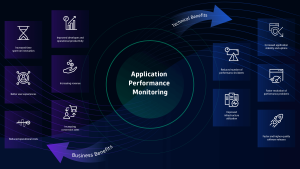For cities, counties, and states that use geographic information system (GIS) apps such as ArcGIS to drive mission critical services, application resilience is essential. With so much at risk during an emergency, ensuring performance apps don’t lag or crash when they’re most needed is vital.
Advanced observability can eliminate blind spots surrounding application performance, health, and behavior for these critical applications and the infrastructure that supports them. Suppose ArcGIS has an unexpected outage. Usually, IT teams scramble with time-consuming and expensive fire drills to find and repair the root cause. Envision if IT teams could be proactively alerted before the field teams discover they can’t complete their gas line maintenance work or load the maps required to fix the freshwater infrastructure in the county. Alerts that deliver actionable data, such as ranking issues and pinpointing the root cause, enable teams to prioritize their efforts on the issues with the most significant user impact and accelerate the resolution.
When considering the financial costs of each hour of downtime, observability delivers a compelling return on investment (ROI). It empowers the team to recover faster as well as proactively prevent outages from happening in the first place.
Gaining a complete picture of app health in hybrid environments
As a starting point, teams should know if ArcGIS and other critical apps are available. While uptime is essential, availability doesn’t ensure optimal performance. This is why application performance monitoring (APM) is essential.
The challenge is that state and local governments operate in highly complex systems — legacy data centers or hybrid environments — crossing multiple clouds. That’s why it’s difficult to understand the root cause of performance anomalies. IT teams need full situational awareness of all assets and an understanding of how they’re performing, including third party vendor apps that were not built in-house.
Agency leaders have just as much to gain from adopting observability solutions as those on the front lines of DevSecOps efforts. Adopting APM can enable staff to improve citizen experience and by extension, agency reputation. Further, APM can improve employee satisfaction by eliminating the manual work of scrubbing every log to correlate events to discover what’s causing a problem with mission-critical software such as ArcGIS.
Understand user interactions with critical GIS software
While it’s important to have an application performance strategy, a top mission for state and local governments is to enhance the citizen experience. An advanced observability strategy includes end user experience monitoring to evaluate digital experiences—such as a website or mobile application—from the user’s perspective.
For example, Real User Monitoring (RUM) can provide an accurate picture of employee or citizen experience with an app. User Session Replay enables IT to resolve customer complaints by watching visual replays to determine exactly what went wrong during a session.
With these tools, agency leaders can empower IT teams to understand how citizens are using digital touchpoints, the obstacles they encounter as they’re using them, and how to eliminate those points of friction, whether in the app, database, or the infrastructure that hosts them.
Automatically discover how infrastructure and database changes impact critical app performance
Full-stack observability gives complete, real-time insight into applications’ behavior, health, the underlying infrastructure, and all other services on which the applications might depend.
Infrastructure monitoring automatically analyzes key health metrics and discovers performance problems caused by infrastructure bottlenecks or changes. As a result, IT teams can proactively identify and resolve potential infrastructure issues with ArcGIS and other critical applications before they impact performance and the citizen experience.
Similarly, observability provides detailed telemetry about the database performance that applications like ArcGIS depend on, including the health of the underlying infrastructure, the state of the database instance, and deep-dive analysis of each database statement and its performance.
Agency leaders can cut costs and improve productivity by eliminating the monitoring tool sprawl that pushes teams to work in silos. With a single source of truth for root cause analysis, IT and DevOps teams can quickly get on the same page about what needs to be done and who’s responsible for it.
Automate vulnerability detection for apps in the IT environment
With growing ransomware attacks, state and local governments must ensure applications don’t contain vulnerabilities that could allow illicit access to sensitive data, unauthorized code modification, or resource hijacking. Ensuring secure applications amid rising complexity is crucial to the digital transformation journey.
Further, applications aren’t as simple as they used to be, and ensuring they’re secure has become more challenging. Whether built in-house or purchased, any application can introduce vulnerabilities into the environment. However, it is more challenging to discover and remediate vulnerabilities when you don’t own the application code.
Full-stack runtime vulnerability analysis provides a holistic view and analysis across all layers of the application ecosystem, so teams have a single source of truth to provide the answers they need. Imagine the team discovers a vulnerability within a third-party app. They can immediately alert the vendor and hold them accountable for the fix to secure your environment. This approach helps agencies eliminate security blind spots and validate that vendors meet the agreed-upon service level agreements.
Ensure IT teams have actionable and scalable data to support the agency and its mission
The challenges agencies face in accelerating digital transformation are obvious, but meaningful answers are hard to come by. Purpose-built monitoring software often becomes shelfware because it’s too difficult to deploy, configure, or understand.
When building the technology stack, agencies must think in the context of the citizen and employee experience. ArcGIS software enables state and local agencies to enhance community service offerings, provide transparency, and engage citizens. Modern observability ensures that IT teams have the tools to appropriately manage and optimize critical application resilience, including ArcGIS performance.
A full stack observability solution enables staff to see it all, top to bottom, from end-user experience to infrastructure health. It also helps teams understand how everything is connected — including all the relationships and interdependencies among layers, components, or pieces of code. These capabilities can help your agency digitally transform faster and more easily — even as cloud complexity increases to ensure that the agency can provide the best possible services to citizens and the right tools to improve employee satisfaction.
Ready to learn more? Download your free White Paper, Advanced observability for ArcGIS and other critical apps for state and local agencies.





Looking for answers?
Start a new discussion or ask for help in our Q&A forum.
Go to forum